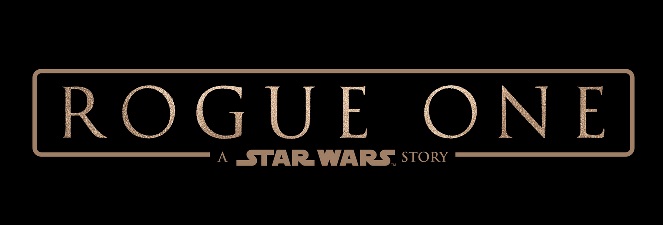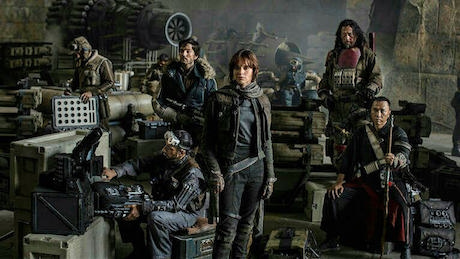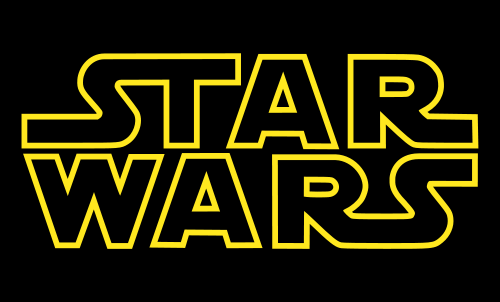The quality of the Star Wars movies has reflected the struggle of the Light Side and the Dark Side. The Original Trilogy and Episode VII dwell on the Light Side as quality films with minor quibbles. The prequel Episodes I-III inhabit the Dark Side as flawed films with minor moments of logic and excitement.
The family saw Rogue One: A Star Wars Story on Christmas Day and enjoyed ourselves. At dinner we had a discussion where we each stated one “Light Side” thing we loved about the movie and one “Dark Side” thing we wish the movie had done differently. Quickly it became apparent that while the Light Side things caused great smiles they were fleeting. What we discussed most were the Dark Side flaws in the movie. Mutually agreed upon flaws that fed on each other.
Rogue One is a Star Wars movie. But judging the quality of Rogue One necessitates embracing both the Light and Dark sides. Rogue One is an enjoyable, flawed film.
***SPOILERS WARNING***
Light Side: The Strengths of Rogue One
Rogue One: A Star Wars story is a stand-alone movie independent of the main Skywalker saga. A movie without a Skywalker at center is a risk and one Rogue One does not shy away from: Rogue One attempts to tell a dark, complicated story of the flawed people who make up a rebellion and their motivations to achieve beyond themselves. To its credit, Rogue One has various cinematic elements that succeed.
Stunning Visuals
Visually, the movie is stunning. Star Wars is known for superb special effects, and Rogue One continues to deliver. X-Wings fly in rain, Rebels and Imperials battle in urban warfare, and dead actors are recreated without a sense of the uncanny valley. From the early shot of villain Orson Krennic and his stormtrooper henchmen walking a desolate landscape towards a farm, Rogue One establishes George Lucas is no longer ham-fistedly directing the camera angles. The visuals add character to this lived-in universe.
Rebellions Are Complex
Narratively, Rogue One shows different facets of the Rebellion, and their conflicting styles. The monochromatic Light Side vs. Dark Side moral simplicity is textured with the gray of disagreements on action and reaction, lost faith in a cause, and the struggle to define meaning in life. This complexity manifests throughout the film, such as with the deftly handled urban warfare on Jedha. This is not an epic battle of Rebellion vs. Empire with red blasters for the bad guys and green for the good. Jedha is a multi-faceted, gritty, smoke filled battlefield where civilians are caught in the crossfire, Rebels kill other Rebels to better keep themselves alive, and lingering one moment is lingering too long. The Empire rolling a tank down an alley with an armed infantry escort looks more like the U.S. in the Middle East and invokes a sense that – in the trenches – what separates the Imperial troops from the Rebellion’s fighters are clothes, not ideologies.
Historical Allusions
Visually, Jedha is a reference to Masada, the hilltop Jewish holdout during the Jewish-Roman war of 73 CE. Textually this allows rich allusions as Jedha, like Masada, is a Jedi (Jewish) stronghold full of zealots who complicate, inspire, and draw condemnation from their fellow Rebels. The devastating final action by the Empire also echoes the Roman siege of Masada. We are left to extrapolate that an Imperial citizen, far removed from the backwater Jedha, would respond to the Rebels’ rallying cry, “For Jedha!” with, “For what?”
Acting Excellence
Beyond the fourth wall, Rogue One’s actors deftly enhance their source material, to the extent they can (see weaknesses).
Forrest Whitaker’s Masterclass
Forest Whitaker delivers the crème de la crème as Saw Gerrera. More happened on Forest Whitaker’s face in the three seconds when he sees Jyn at Jedha then happened on some actors’ faces over the whole movie. Saw, though bluntly named, is the movie’s most complex character. He saved Jyn but abandoned her. Saw is a guerrilla general no longer able to physically fight. Allusions to other characters abound: Saw is mostly mechanical and uses a breathing machine like Darth Vader, is both treacherous to Rebels and loyal to the Rebellion like Lando, acts as Jyn’s Obi-wan protector, and cages bizarre animals akin to Jabba the Hutt. Reshoots or no reshoots, necessary or not, Whitaker was used too little and gave the most.
K-2SO & The Brothers Jedi
Alan Tudyk was in every scene physically as K-2SO. He was standing on stilts towering over his costars. So when K-2SO improvises and smacks his male Rebel copilot, Cassian, it is actually Tudyk improvising in the scene. For a monotone, motionless metal faced droid, Tudyk imbues K-2SO with a lot of personality. Motion capture (e.g. Gollum, Smaug) has become sophisticated to the point we forget the actor is still the genesis of the character. Tudyk does his best to make sure we remember him.
The two Jedi brothers, Chirrut (the blind one, played by Donnie Yen) and Baze (the gun one, played by Wen Jiang), were a beautiful pair. They livened up their dour compatriots and added ethnic diversity to a galaxy that for a while added ethnic diversity through latex (Rogue One as a whole did diversity well with Diego Luna, Riz Ahmed and others. Episode VII also deserves props). I could watch a whole movie of the two brothers, faith and skepticism, so full of love for each other their mannerisms make them weary. They were the heart of the movie. Knowing they were on board turned the Rebel strike team into a noble mission, not a collection of scarred loners.
End on a High Note
Rogue One went all out for the third act battle. Every aspect of the battle mattered – the space dog fight to destroy the planet shield and allow the transporting of the Death Star plans, the infantry forces engaging their Imperial enemy as a distraction so those plans may be stolen, and the small strike team finding and transmitting the plans. It was refreshing to watch nameless commanders be given orders and carry them out with little information and know, as the viewer, every action was vital to success. There’s no narrative shorthand where top-billed actor/hero does all the work and scores of extras die without consequence.
[Aside] I mean, everybody dies, but it’s a group accomplishment.
The third act also contains plenty of exciting visual flourishes. A space cruiser ramming a disabled Star Destroyer into another Star Destroyer! The Mon Calamari Admiral Raddus looking down on the planet Scarif from the center of a bubble in his space cruiser. AT-ATs emerging through the jungle. And the coup de grâce…
Darth Vader laying waste to a corridor of rebels. From entrance to ejection, that one sequence is worth the price of admission.
And Yet…
Rogue One rides through 133 minutes on strengths of visual brilliance, moral complexity, historical inspiration and allusion, acting strength, and an epic all-in third act.
So why did we not love it?
Dark Side: The Weaknesses of Rogue One
Much has been written and speculated about the rewrites that significantly changed Rogue One. And while I have seen numerous articles ask what kind of movie Rogue One would have been in its original form, I do not want to see it. The released Rogue One was improved by the rewrites and yet still has major flaws.
Heroine Straight-jacketed by Plot Devices
Show Don’t Tell
Jyn Erso as heroine, remarkably, has little impact on the plot for most of the movie. Why is she a heroine? Because her mom is dead? Because she’s a badass? All of Jyn’s backstory is verbalized instead of shown when meeting with Saw on Jedha. She was Saw’s “best fighter at 16?” Sounds cool, why didn’t we see that? Saw abandoned her to avoid her being used as a pawn? Sounds dramatic, why didn’t we see that? Jyn is stoic to the point of silence up until Jedha, yet upon meeting Saw she word vomits her life story? Felicity Jones’ face clearly has Jyn thinking interesting thoughts…can we see their genesis?
 Daddy Issues
Daddy Issues
Jyn’s character arc feels a lot like Rey from The Force Awakens. She is an orphan, forced to live on her own, then has to process the death of her adoptive-ish father, Saw, only to then process the death of her absent-ish father, Galen. Same emotion 20 minutes apart. Neither is nearly as interesting to watch as Felicity Jones’ beautiful breakdown upon seeing her father Galen as a hologram, so why bother with the deaths?
Starting with the death of Galen, the loss of her absent-ish father would have been more impactful on Jyn if Saw was removed as an unnecessary character (below). Processing the death of multiple father figures cheapens their impact. Galen’s death would also have been more impactful if absent-ish father had been a single parent. Mom’s death facing down villain Krennic and his squad of stormtroopers is a plot contrivance: Mom is simply in the script to die. What is Mom planning to do, shoot all six stormtroopers with her gun under a blanket? If Mom was already dead/absent/not in the movie, young Jyn’s relationship with her father is more intense and filled with more loss and confusion that her father never contacts her.
To sum up, just before Cassian (male rebel lead) pledges to join Jyn on her suicide steal the Death Star plans mission, I heard “If another man walks out on her I’m going to vomit.”
Uninspiring Motivational Speeches
Can you recite any of Jyn’s motivational speech? How about Cassian’s right afterwards? Ok, tell me your favorite line of dialogue from K-2SO? So, yeah, definitely not Independence Day.
To underscore how uninspiring it was, Jyn’s speech came at the exact moment the Rebels were disintegrating and needed a rag-tag team to strike out on their own and SERIOUSLY NOT EVERYONE VOTED TO STEAL THE DEATH STAR PLANS! IT’S A DEATH STAR! AS IN DEATH TO STARS! AND PLANETS!
Unnecessary Characters
Saw Gerrera
As interesting and nuanced as Forest Whitaker makes Che Guevar–, sorry, Saw Gerrera, the character is unnecessary. Saw does not advance the plot in any appreciable way and could be written out. Speculation on the rewrites is Saw was mostly written out already. How is Saw unnecessary? Try this:
Rogue One synopsis: Jyn’s father gives Pilot Bodhi a message and tells him to find Saw for delivery of message to Jyn.
Rewrite without Saw: Jyn’s father gives Pilot Bodhi a message and tells him to find Jyn for delivery of message.
Pilot Bodhi can still go to Jedha, can still get caught by extremist rebels (or just seek safety with them), and can hand Jyn the hologram instead of Saw. Jyn as the lynchpin for discovering the Death Star’s weakness is increased without Saw since Jyn’s father is trying to directly contact her. Unnecessary characters make for weak plotting.
Pilot Bodhi Rook
For that matter, the Pilot Bodhi could have been written out of the first act as well. Bodhi’s entire character arch is in the last act/final battle where he is a one-man army of subterfuge and communication resourcefulness. Once it starts it’s a great character arc, but why is Bodhi in the beginning? To get Jyn via Saw a message from Jyn’s father? How about a secret message lands in her lap in jail, something cryptic like “Go to Jedha?” Or the Rebellion gets a secret encrypted message that tells them only Jyn can crack it? Instead, we get Pilot Bodhi who Saw throws to a creature that robs Bodhi of his sanity, only the next time we see him Bodhi recovers almost immediately?
Jimmy Smits/Bail Organa
I want everyone to know I love Jimmy Smits. Liked him in NYPD Blue, like him now. However, his portrayal of Bail Organa in Star Wars movies is pointless. The role of Bail Organa is to be either the physical embodiment of a name drop (Bail Organa is Leia’s adoptive father!) or actually to name drop (“Captain Antilles…”). Casual Star Wars watchers (like my parents, who have seen every movie) do not know who Bail Organa is or why he’s important because there’s only one minor (very wooden) scene at the end of Ep. III Revenge of the Sith that alludes to his importance. Oh look! There’s Jimmy Smits choosing to take the baby Leia!
When Jimmy/Bail first appears in Rogue One, the Rebellion is having a strategy meeting. As he enters, the “Binary Suns” theme (the melancholy theme everyone associates with The Force and Luke Skywalker) plays. This invokes a feeling of nostalgia, “It’s the Force! Something important is happening!” We feel Bail Organa’s entrance is important … but it’s not. Jimmy Smits has no dialogue here and quickly disappears from the scene. Forty years of good will generated through music is wasted on a mute cameo character’s entrance.
Who Is That?
The first act of Rogue One visited half a dozen worlds where mostly men and male extras dress in black or very, very dark gray (including Krennic’s stromstroopers) and scowl. Top to bottom, the characters are hard to distinguish from each other. Every casual Star Wars fan in my family (Mom, Dad, NoApologiesAdvocate) named this their number one complaint. Personally, I did not have difficulty distinguishing characters as I zero in on faces very well, but I left the movie not knowing certain main characters names.
“Who was the main male rebel, the friend of K-2SO? …[look at IMDb]… Cassian? Whatever.”
“I liked Forrest Whitaker as Saul.”
“His name was Saw.”
“Seriously? I like Saul better.”“What were the two Jedi brothers names?”
“Blind one and Gun one?”
If I do not know a character’s name either a) they weren’t given one or b) they weren’t memorable enough for me to care.
Lacking Heart
The Jedi Brothers
Given my previously stated love for Chirrut (the blind one) and Baze (the gun one) I am not arguing their characters lacked heart. No, what lacked heart was the biggest travesty: their deaths.
Scene:
Chirrut bravely and faithfully walks through a battlefield chanting only “I am one with the Force. The Force is with me.” He traverses the battlefield unharmed and allows the Death Star plans to be transmitted!
Then Chirrut is killed!
Baze, overcome with emotion, (re)discovers his faith in the Force and follows his friend into death taking down minions of the Empire. Epic, beautiful music swells!
Except it doesn’t.
Music does swell but without emotional investment from the audience. How can we emotionally invest when we have not heard this theme before and/or do not recognize it? Easy. Take The Force theme from Bail/Jimmy Smits and play it over the Jedi brothers’ deaths. The brothers are one with the Force, the Force is with them, and yet, the one theme everyone associates with The Force is not played during the binary sons acceptance of The Force! That theme is the heart of Star Wars music, give it as a fitting sendoff for the heart of Rogue One.
K-2SO is no Groot
K-2SO is a great idea. K-2SO is a character. K-2SO in Rogue One is not a great character. Fun? Yes. Enjoyable? Of course. Nice levity in a dark film? Certainly.
The problem comes from a missing piece of ephemeral humanity. K-2SO, like Groot, Data, WALL-E, and Roy Batty, is a Pinocchio character, a non-human who reflects core tenets of humanity back at the audience. A cold alien character shows human warmth. K-2SO, however, never overcomes his droid coldness. There is no “We are Groot” moment. No struggle to handle human emotion. No kiss from EVE. No “Tears in the rain.” Maybe it is because K-2SO has no face to emote or maybe because K-2SO dies alone, but Alan Tudyk does not have enough given him in the script to overcome the cold steel of his CGI droid body. K-2SO dies saving his companions. It’s noble. It’s expected. But it lacks humanity.
And Yet…
Rogue One stumbled through 133 minutes on weaknesses of a tired trope of a heroine, unnecessary characters, unnamable characters and lacking memorable heart.
So why did we not hate it?
The Force is with You, Always
Rogue One is a Star Wars movie. Star Wars has released episodes of pop culture and cinematic brilliance. Star Wars has also released episodes clearly flawed knowing lack of quality will not hamper box office receipts. Rogue One, reflective of its nuanced subject matter, embraces both the Light and Dark sides. Rogue One is an enjoyable, flawed film.



The CNotebook Editor